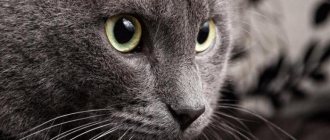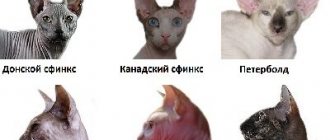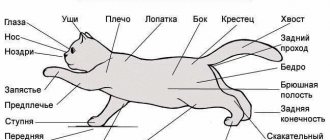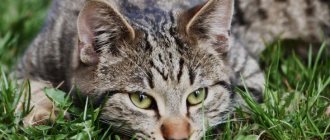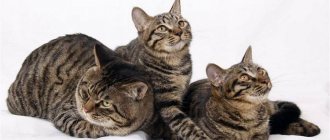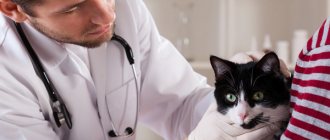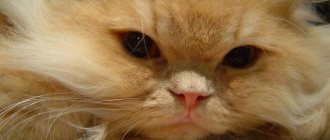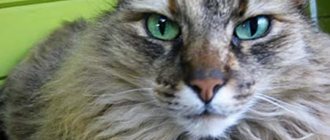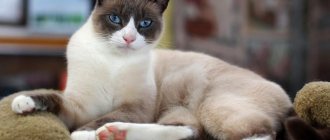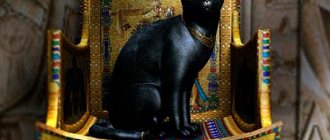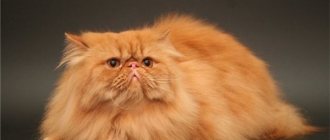Norwegian Forest Cat: history of the breed
The Norwegian Forest Cat is the official cat breed of Norway. Individuals of this breed are semi-long-haired and large in size. This breed is especially popular in Northern Europe. In Norway it is called Norsk Skogkatt, Skogkatter or Skovkatter (from "skog" and "skov").
Norwegian Forest Cat and declared the official breed of Norway
There are several theories about how this breed came to be. According to the most common version, Angora cats came to Europe in the 16th century. Over the years, the breed has adapted to the snowy climate. The cats lived in “Spartan” conditions, got their own food and climbed trees a lot. Therefore, animals of this breed have powerful legs and tenacious hunting claws. But then hunting cats began to interbreed with other species, which contributed to the development of a separate breed - Norwegian forest cats. According to another version, the wild cat Felis silvestris grampia (brought by the Vikings from Scotland) mutated to suit the northern climate.
The breed of Norwegian cats was first described in 1599. And the first registered Norwegian cat was a pet named Pans Truls, thanks to the recognition of the breed by felinologists. Fédération Internationale Féline recognized the Norwegian cat as a separate breed in 1977. Felinologists call these cats “Wegie” (short for “Norwegian”).
However, in the second half of the 20th century, active breeders mated Norwegian cats with other breeds. So the forest cat could disappear, and the Norwegians created a special committee whose work was aimed at protecting the breed from extinction. To register a pet as a representative of the breed, the owner had to bring it to the committee for inspection. If the pet looked like a Norwegian cat, he was given the appropriate papers. It was possible to participate in any cat show only after going through this procedure.
Historical information about the origin of the breed
There are two hypotheses for the formation of this breed. The first connects its appearance with the Viking raids. Scandinavian warriors brought Angora cats to their homeland from Turkey. Crossing with local stray animals made it possible to obtain a new breed.
According to the second version, Norwegian forest cats are the result of a mixture of domestic pets and lynx. This version is confirmed by the presence of brushes, sharp, strong claws and the ability to overcome obstacles at high altitudes.
Standardization of this breed was carried out in the last century. After the international recognition of the Norwegian forest cat, its breeding began. Now representatives of this species are popular on all continents; they take root well in all climatic conditions.
Description of the breed
When owners of Norwegian cats are asked to describe their pet, breeders begin to talk about the calm character and aristocratic manners of the animal. Forest cats are smart and unpretentious, so they are suitable for indoor keeping. However, like representatives of any other breed, Norwegian cats are characterized by peculiarities in appearance.
The appearance of a Norwegian cat is difficult to confuse with the appearance of representatives of other breeds
My Mira is sociable and appreciates people's attention. If I enter the room where she is sleeping, I immediately hear a loud purring, although outwardly she may not move. The Norwegian Forest purr is really very loud, you can hear it in the next room. But she meows infrequently, only when she feels that feeding time has come, but she has forgotten about it. Only then does she begin to resent my forgetfulness.
Margocha58, forum visitor
https://otzovik.com/review_2564777.html
Appearance
Forest cats have a triple coat (this differs from many other breeds):
- undercoat (thick, “downy” hairs, like cotton wool);
- main coat (the back, sides, and top of the tail are especially densely covered with fur);
- outer coat (the longest, shiny hair along the ridge and tail, which has a water-repellent effect).
Norwegian cats have evenly furred tails
In addition to the fact that the cat seems large due to its fluffy hair, it also weighs a lot. Males can weigh up to 10 kilograms (females slightly less). The body of such a cat is long and massive, the front legs are shorter than the hind legs. The animal's limbs are heavy and its feet are wide. Tufts of fur stick out between the fingers. The tail of the Norwegian cat is long (the length of the tail is equal to the length of the body), almost evenly pubescent to the tip. Norwegian cats have a narrow head to the chin with well-developed cheekbones. The nose is long and straight. The ears are set high on the head and wide at the base. In general, these cats have large and mobile ears, and at their tips there are tassels that start from the inside. The eyes of a forest cat can be of any color, but their distinctive feature is their shape. These are almond-shaped, wide-set eyes (wide, narrowed on the outside).
Unlike some breeds, the color of the Norwegian cat can be almost any color. The exception is the color with shaded paws, ears and muzzles. A Nordic pet cannot look like a Siamese or Thai cat.
The drawing of forest cats is clear and expressive. A characteristic feature of the Norwegian is the “tie”. It is a lighter shade than the main coat and has longer hairs (resembling a beard). Some cats have white patches (paws, beard, tassels). The paw pads are the same color as the coat. In addition, some cats have a thin stripe on the nose that matches the main color. Due to their size and fluffiness, Norwegians are sometimes confused with Maine Coons. Therefore, when comparing, you need to take into account all the distinctive characteristics at once, including the non-standard shape of the head and the shape of the eyes.
Character
Big forest cats have a soft and kind character. This breed is one of the most patient and forgiving. Such a cat will not show aggression even if another animal (or child) tries to provoke it. The forest cat will be gentle and attentive towards its owner. The animal will quickly get used to its person, will love and accompany him. The attachment to the owner is due to strong intelligence and kindness. Such cats remain brave, but cheerful throughout their lives. But despite their kindness, Norwegians are hunters. Instincts will manifest themselves in attempts to explore all the most inaccessible places in the house.
Nordic pets bask in the love of their owners thanks to their gentle nature and love of life
They get along with everyone, not only children, but also with dogs, unobtrusive, non-aggressive, self-sufficient cats. The character is calm, Nordic, good health. On a cat forum, one breeder told how her Norwegian cat was lost, found a month later - stuck in an elevator shaft, sat there without food for 35 days, but survived! They pulled him out in a comatose state, but gradually came to his senses.
Vitusik, Regular forum participant
https://mama51.ru/forum/index.php?topic=54420.0
These cats are reserved and cautious with strangers. Of course, natural curiosity will do its job, and the cat will definitely “take a closer look” at the visitor. And if a stranger does not show aggression, then the cat will repeat the behavior of the owners and sit next to the guest. A noble pet can bond with all family members at once. The animal will not care where it is, as long as it is close to its family. They have a hard time being alone. Feeling like a full member of society, the cat will make it clear that she does not like hugs and kisses. But she will happily sit (lie next to her), thanking you for the stroking with loud purrs.
Some owners of Norwegians think that cats repeat their behavior
Norwegian cats do not know how to take revenge. Even if, for example, a child harms a cat, it will not hold a grudge, but will step aside. The ability to adapt to the world around us is manifested in everything. For example, such a cat can live in a private house. Moreover, in the yard she will be cheerful and mischievous, and upon crossing the threshold of the house she will turn into an affectionate aristocrat. Such a pet will not offend other animals. An intelligent animal will immediately understand who else the owner considers to be his fellow tribesman (dog, hamster, turtle, etc.).
Very talkative, when someone scolds her, she immediately runs to complain to someone at home. She works part-time for us instead of an alarm clock, she starts yelling within two minutes, and when it’s a day off, she meows too, but when you tell her that today is a day off, she immediately calms down and goes to bed calmly.
Natalia, forum user
https://mirkoshek.rf/forum/forum2/topic74/
One of the rare features of the Norwegian cat is the ability to descend from a tree upside down in a spiral (like a squirrel). Forest cat babies have a rare ability (when their mother drags them from place to place, they grab onto their parent with their paws).
Flaws
Disadvantages of a Norwegian breed cat can be dry, shedding and excessively silky fur. Cats are also prone to excess weight, so don’t forget about regular exercise. The rest depends on the accepted standards of the breed, for example, the ears should be huge and set high. They are wide at the base and tapering towards the top. The outer contour of the ears continues the natural line of the cheekbones. The ears are decorated with lynx brushes and tassels, which makes them incredibly attractive.
The standard of the Norwegian cat dictates everything, down to the length of the coat and eye color. Thus, representatives of the race have huge almond-shaped eyes of green or green-gold color. The eye color should be in harmony with the color and be evenly distributed in the iris. With a white color, a cat can become a happy owner of blue and light blue eyes.
Purchasing a kitten
As a rule, wild cat kittens are born healthy and strong. They become covered with outer coat at the age of three months, but become fully grown by the age of five. Buying a Nordic kitten is difficult. There are many advertisements on the Internet and newspapers about the sale (or gift) of these babies, but it is almost impossible to verify the purebredness of their breed. But if you need a kitten for yourself (for the soul), then you can resort to advertisements. But if purebredness is extremely important (for example, for breeding), then it is better to contact either professional breeders (and there are few of them) or a nursery. The fact is that nursery employees and volunteers are not interested in deception, so the risk of being deceived is minimal.
Norwegian kittens are very similar to their parents (they can be identified by the shape of their eyes and the length of their paws)
Such a kitten can cost up to 25,000 rubles. The price depends on several factors:
- purity of the breed (with pedigree is more expensive);
- coat color;
- city (large cities are more expensive);
- prestige of the nursery.
If a kitten is bought second-hand, then the price can range from 1000 rubles and more.
Criterias of choice
When choosing a Norwegian baby, you need to pay special attention to the following criteria:
- age;
- health;
- behavior;
- pedigree;
- health of the nurse cat.
It is advisable to adopt a kitten at the age of three months. First, you need to wait until the cat has taught her baby everything (use the litter box, eat, play, etc.). In addition, primary immunity is instilled in the baby with the cat's milk. The exception is if the kitten has lost its mother, and feeding her with milk is already impossible. And secondly, up to three months the kitten is vaccinated. If the baby is of suitable age, you need to examine the animal. He must be active, clean, without any damage to the coat or skin. Some are guided by the rule “the kitten chooses its owner.” If a cat rushes into your arms, this may be just such a case. Pay attention to the documents. A purebred Norwegian must have a pedigree. The more ancestors of a cat are known, the better. Finally, examine the cat. A healthy cat has a healthy kitten. Naturally, you can make a discount on feeding. Mommy may be a little lethargic and her coat may be slightly dull.
Vaccination and pet health
Cat diseases are often the result of management errors. They may exhibit glycogenesis and anemia due to a lack of red blood cells. Glycogenesis is a congenital disease; kittens die from it at the age of 5 months.
Just like for any cats, it is important to prevent the occurrence of common feline diseases by performing timely vaccinations according to standard schedules.
Keeping a Norwegian Forest Cat
Raising a Norwegian is not difficult. But like any other animals, forest cats require attention and care. In order for a cat to please with its appearance and good health, it needs to be provided with proper nutrition and proper care. Some representatives of this breed have their own habits, which they teach their owners (how to wash them, how to feed them, etc.).
In order for a kitten to grow up strong and healthy, you need to take good care of it
He doesn’t beg for food, but simply when you forgot to fill his plate with the allotted food, he sits down near the bowl and looks at you with silent reproach.
Forum guest
https://mirkoshek.rf/forum/forum2/topic74/?MUL_MODE=&PAGEN_1=2
Nutrition
Norwegian cats are not very picky when it comes to food. They can be fed dry food or natural products. A large forest cat needs up to 500 kcal per day. If you feed her dry store-bought food, it will be approximately 120 grams. You need to remember about the quality of food (you can consult a veterinarian). When it comes to natural products, the diet must be designed so that the food is balanced and complete. Carnivores need filling food, so 1/3 of their daily food should contain protein. When feeding homemade food, you need to use high-quality products:
- scalded lean meat (beef, veal, turkey);
- boiled offal;
- boiled fish, deboned;
- eggs;
- low-fat fermented milk products;
- cereals (rice, buckwheat, oatmeal);
- vegetables (can be boiled and mixed with porridge).
The health of the animal depends on the quality of nutrition
It is important to remember to maintain balance in food. There is no need to give preference to any one product. The menu should be designed so that the pet receives all the necessary microelements.
The number of feedings per day depends on the age of the pet. Small kittens (from three months) need to be fed 3-4 times a day (after all, they need to gain weight and develop). Teenage cats are fed 2-3 times a day (gradually they need to be switched to two meals a day - morning and evening). Adult cats, sterilized females and neutered males are fed once a day. Adults are already large, and over time they will also gain weight, so there is no need to overfeed them.
Appearance care
Due to the thick undercoat, the cat needs to be brushed regularly. In the cold season, it is enough to brush your pet once a week. For this you can purchase special combs:
- brush with synthetic bristles (suitable for caring for kittens and teenagers);
- a comb with long and/or dense teeth;
- slicker (slicker).
Which comb you use to treat your pet depends on your patience and the cat’s behavior. During the warm season (spring), the cat will shed heavily. The soft, fine, thick hair of the undercoat will fall out. Of course, they can settle on carpets and clothes, but most of them will remain under the long fibers. They need to be combed out. When molting, such procedures need to be carried out daily. Most Norwegians enjoy brushing (as long as it's painless), so this shouldn't be a problem. If you ignore this rule, your cat may develop tangles, and this is dangerous (the tangles can harbor parasites). As soon as the cat's fur becomes dirty, the cat can be bathed. To do this, you need to purchase a special cat shampoo (and you can also use a balm - it makes it easier to comb after). You need to dry your cat using blotting movements, but without rubbing the fur.
most Norwegians are not against water treatments
Once a week you need to wipe the corners of your eyes. A soft cloth is useful for this (1 for each eye). You also need to treat your ears. Examine the ear (inside). If there is any irritation, inflammation or soreness, you need to purchase a special product from a pet pharmacy or make a solution yourself (vinegar and water in a 1:1 ratio). To care for claws you need a scratching post. If you don’t have the experience (and you can’t do a cat “manicure”) and the means to attract a groomer, then a scratching post is an ideal option.
An animal's toilet is very important. Cleanliness in the tray is necessary not only for the absence of an unpleasant odor in the house, but also for the health of the cat. Firstly, a dirty litter box can cause a cat to get sick (toxoplasmosis, etc.). In some cases, the cat may act as a carrier of the disease, and the owner will suffer. And secondly, on the back of the cat’s body the fur is especially soft and thick (there are few guard hairs). This fluff quickly becomes dirty, and the animal is not able to cope with so much wool on its own. The filler needs a large fraction (ideally mineral pebbles, they do not crumble). In this case, grains of filler will not stick to the paws and get stuck between the fingers. In general, litter manufacturers write information on the packaging about what type of animal the product is recommended for.
Features of feeding and diet
Nutrition is an important aspect in the life of Norwegian giants, as they expend quite a lot of energy. A truly large pet requires a large portion size. The feeding rate is determined by the weight of the animal, its physical activity, and age.
Feeding a kitten begins at 1 month of age. To begin with, food should be four times a day, from 4 months they switch to three meals a day, and from 6 months onwards it is enough to feed the pet twice a day. It is important not to overfeed your Norwegian to avoid causing obesity or food allergies.
A cat's diet needs to be properly balanced. In this case, the food can be natural, industrial, or a combination of these two types of food. When using dry and wet industrial feeds, you need to purchase premium professional brands. They contain all the beneficial substances cats need, while their cheap analogues can cause irreparable damage to the pet’s health.
Natural nutrition should contain a fairly large amount of protein, a minimum of carbohydrates and be enriched with vitamin and mineral complexes.
The basis of the stogkatt diet is lean meat products: beef, veal, chicken, turkey, and offal. Low-fat dairy products and cottage cheese are given not only to kittens from one month of age, but also to adults. It is useful to add boiled and chopped vegetables to your cat’s menu. The most useful for them will be pumpkin and carrots.
From cereals, you can sometimes give oatmeal porridge cooked in meat broth.
For any diet, prohibited foods include:
- sweets;
- berries and fruits;
- flour;
- tubular bones;
- River fish.
You should not encourage your pet to beg. Having given in once, it will be difficult to wean him from this bad habit.
As a source of vitamins, it is recommended to sprout in pots and treat the animal with tender green oats or wheat. They contain substances necessary for the proper functioning of the Norwegian gastrointestinal tract.
Defects of the Norwegian forest breed
Many animals (breeds, species, etc.) are predisposed to some kind of developmental disorder or disease. It is impossible to predict whether your cat will get sick. But you cannot protect your pet from genetic “gifts”. Therefore, it is very important to know what your pet can get sick with.
Norwegian Forest cats are prone to a number of diseases
Tendency to diseases
Norwegian cats can be born with glycogenosis type IV. If at least one of the parents is sick, the kitten inherits this gene. Sometimes such babies are stillborn, and some die immediately after birth. If the kitten survives, this is not a guarantee that it will live long (sometimes only up to 5 months). Moreover, owners cannot always find out about the presence of this disease. The gene can only be identified using genetic analysis. This procedure is not available to all Norwegian owners, but a professional breeder can spend the money. Another hereditary disease is polycystic kidney disease. This disease destroys the kidneys and the animal may die. Polycystic disease can be diagnosed using ultrasound.
In addition, Norwegian kittens can transmit heart disease (hypertrophic cardiomyopathy). This disease most often affects male cats rather than male cats. The walls of the left ventricle of the heart and the interventricular septum thicken, and the ventricular cavity decreases. This leads to enlargement of the atrium and disruption of the myocardium. The heart muscle cannot function normally. Hypertrophic cardiomyopathy can be recognized by the following symptoms:
- heavy breathing (sometimes wheezing or “gurgling”);
- dyspnea;
- tachycardia (rapid heartbeat);
- mucous membranes become bluish;
- heart murmurs;
- hydrothorax (fluid accumulation in the chest cavity);
- high blood pressure;
- fainting;
- thromboembolism (the hind leg may fail, sometimes both).
If your Norwegian has at least one of the listed symptoms, then you need to urgently contact a veterinarian. Forest cats can also go blind because they are prone to retinal dysplasia. Due to the disease, spots appear on the cat’s retina, which leads to decreased vision. But domestic cats can live blind (if they are cared for properly).
Defects in appearance
Pedigree cats must strictly comply with breed standards. Otherwise, the animal may not be allowed to participate in exhibitions and shows. For domestic cats, defects in appearance are not so terrible, and each feature will be perceived by the owners as a “highlight”. A defect in appearance is any deviation from the standard.
any purebred cat can have “flaws” in appearance
For example, a Norwegian should have a wild, slightly slanted look, but not an evil look (and not squint). The muzzle should be in the shape of an inverted triangle, but not elongated. The legs should be powerful and short, but not so short that the cat touches the floor with its belly when walking. If the characteristics of the breed are hypertrophied, then this can already be called a defect.
However, with such features, a cat can enter the exhibition as a participant, and experts will evaluate the purebred. The following signs may be grounds for disqualification:
- strong break of the nose (a noticeable transition from the forehead to the nose);
- square muzzle (cheekbones should be distinct and the chin should be pointed);
- pinch on the mustache pads (the pads should not protrude too much);
- long rectangular body (the back of the body should not be more massive than the front);
- cobby build (stocky);
- wrong number of fingers;
- strabismus;
- fractures and defects of the tail;
- weak bones;
- overshot or undershot jaw;
- the presence of traces of hybridization in color (interspersed with a separate color or pattern that the parents do not have).
Breeding issues
If a male cat fully complies with breed standards and is allowed for breeding, there is a need for mating. The physical development of female Norwegian forest cats ends by the age of four. Early mating, pregnancy and childbirth will weaken the pet, and growth will stop prematurely. The first mating is recommended at two years.
- Estrus. The breed is large in size - the first heat begins late. Behavior changes - the cat becomes more affectionate, sometimes restless. If mating is planned, before the next estrus occurs, the cat is taken to the veterinarian and dewormed.
- Knitting. It takes place on the cat's territory. The cat with all the necessary accessories and a supply of food is left with the male’s owners for several days. You cannot breed a Norwegian Forest cat with other breeds - there is a high probability of giving birth to weak offspring with genetic abnormalities.
- Pregnancy. The average length of pregnancy is about nine weeks. Typically, pregnancy and childbirth proceed without complications. Changes are made to the diet - the daily portion is increased, specialized supplements containing folic acid are given.
If a cat or cat has poor health, deviations from the standard, the need for castration and sterilization is considered. After castration, cats become calmer and do not strive to mark their territory. Sterilization improves the cat's health, reduces the risk of developing certain diseases, and increases life expectancy.
Breeding
Representatives of any breed that originates in the wild have highly developed instincts for procreation and preservation of offspring. These instincts continue in the home environment. Often domestic cats do not need help with either giving birth or raising kittens. But a lot still depends on the breeder. The owner of a purebred cat must find a suitable partner and ensure mating. Usually the owner of a Norwegian tries to meet his future partner personally. Sometimes you even have to go to another city to do this.
Even a non-professional breeder can cope with breeding Norwegian cats
If the cat is purebred, then the cat must match. And age, I think, is not the main thing, you can be younger, the main thing is that the cat is experienced.
vikatiras, forum regular
https://pro-cats.ru/forum/74–4262–3
Criteria for choosing a partner
Inexperienced cat breeders are looking for equally beautiful partners for their Norwegian cats (often also Norwegian). In this case, only the appearance of the cat is assessed (less often, purebred). But the owner of a potential partner may be more experienced. In this case, the cat may not be provided for mating. Few people would want to mix a titled cat with a non-purebred cat. Therefore, before you start choosing, you need to learn how to evaluate the possibility of mating. The likelihood of consent from the partner’s owners and the health of the offspring depend on this. There are 4 main criteria:
- pedigree;
- appearance;
- color;
- blood type.
The most difficult thing about breeding Norwegians is finding a suitable partner
It is not necessary to look for the ideal representative of the breed, you need to find a suitable partner. The presence of titles and regalia does not guarantee the birth of beautiful, healthy offspring. In order for kittens to be as beautiful as their parents, it is advisable to choose a partner who is as similar as possible to your cat. This may be an individual from the same breeding line. Such an animal can be found from the same breeders where you got your pet. When mating relatives, beautiful kittens should be born (provided that the parents are outstanding representatives of the breed) with a good phenotype. This mating is called inbred.
Some forest cat owners are afraid of related matings, and sometimes it is difficult to find a partner from the same pedigree in the right city. In this case, you can choose a partner based on appearance. It is necessary to evaluate the advantages and disadvantages of appearance (head shape, coat quality, distance between ears, etc.). But this method is convenient to use for those breeders who have already learned to distinguish the characteristics of the breed. If you don’t have such skills yet, you can ask the owners of a potential partner for an assessment sheet. This is especially appropriate if you want to adjust the breed of future kittens. For example, if your cat has weak and slightly dull fur, then the cat’s hair, on the contrary, should be ideal.
If you do not have experience mixing cats with different colors, then you need to look for a partner of the same color as your cat. This will increase the likelihood of having kittens with high-quality color. It is also important to take into account the pattern on the animal’s fur. You cannot mix a marbled specimen with an animal, for example, black and white (bicolor). From such a mixture, kittens of both colors can be born, but the pattern will be of poor quality. Marbled kittens may have black or white spots, and black and white babies may have vague patches of merle color. Such nuances are called color defects. It will be difficult to sell such kittens (but you can give them to friends or keep them for further breeding).
In order for the kittens to turn out beautiful and similar to their mother, it is advisable to look for a partner of the same color as her
Cats can have one of three blood types (A, B and A/b). They also need to be taken into account. Cats with group B can be crossed with any cat. And females with the same blood group cannot be mated with males of group A. If this rule is violated, kittens may be born with a disease such as hemolysis. If a cat with blood type B gives birth to kittens with type A, then the offspring must be taken away from the mother immediately, otherwise they will die (after living only a few hours). The babies will have to be fed artificially for three days. The surviving kittens will not be able to become champions of the breed, since after illness the tip of their nose will fall off. To avoid such troubles, you need to know your pet's blood type in advance. The corresponding tests can be done in special laboratories (they are not available in every city).
At what age should you give your pet for the first mating?
Full maturation of a Norwegian cat will occur around the age of 5. Therefore, there is no need to try to mate a young cat. But I also don’t want to wait 5 years, so the first mating can be organized in 2–3 years. If a cat lambs before this age, then its growth and development may “freeze.” She will not grow any further, which means she will look much smaller than her adult relatives. Males can be mated as early as one and a half years old.
A female with a Nordic character will not allow just anyone to approach her. In general, cats of this breed may avoid any communication with other people's animals. But the male, already in adolescence, will “molest” all the cats he finds nearby (including cats of other breeds and outbreds). Kittens can be born beautiful hybrids, but that is not the problem. Someone else's cat (especially a mongrel cat) can infect your cat with some kind of disease. Therefore, a cat that goes outside needs supervision.
Before mating, both individuals must undergo helminthiasis prevention. The procedure for mating a Norwegian cat takes 3–5 days. But even before mating, the owners of both animals can agree on a reward (this is not necessary). If the mating was successful and the cat became pregnant, then the owner of the male is entitled to a kitten from this litter or money (equivalent to the amount of one kitten). Particularly experienced breeders can even enter into written agreements with each other, which will describe in detail all the terms of the transaction.
Video: Norwegian cat courting a female
How often can a cat give birth?
If the owner of the female does not control the frequency of births and does not provide organized mating, then the cat can give birth 3-4 times a year (maximum 5 times). Frequent pregnancy and childbirth can lead to illness in your pet. The fact is that the body of cats that often give birth weakens and does not have time to recover. If there is too little time between births, the following problems may occur:
- weight loss;
- rachiocampsis;
- disturbances in the functioning of the nervous system;
- respiratory tract diseases;
- diseases of the reproductive organs;
- hepatitis, necrosis, etc.
A tired cat has a weakened immune system, which means there is a risk of catching some kind of infection. For these reasons, you should not turn your furry cat into a birthing machine. In addition, mating is an expensive undertaking in itself (sometimes the partner lives in another city). Typically, breeders breed their forest cats 1–2 times a year.
Colors
The breed is characterized by wild colors given by nature. Chocolate, sable, color-point, lilac colors and their combinations with white are not allowed.
Plain
In these colors, the hairs of the coat must be colored entirely. There are blue, red, white and black Norwegian Forest breeds.
Smoky
The fur is partially colored. It seems as if the cat is enveloped in a light smoke.
Tabby
Wild color with stripes, spots and other patterns on the cat.
Marble
The characteristic fur pattern is made with thick and smooth lines.
Multicolor
Acceptable colors are solid colors in combination with white. Tortoiseshells and calicos are acceptable.
Castration and sterilization
Owners of Norwegian cats may not want offspring at all. But if an unsterilized cat never gives birth, this can lead to female diseases (including uterine cancer). Cats are neutered (if kittens are not wanted) for the reason that they mark territory. For castration and sterilization, you can contact any veterinary clinic. During the operation, the gonads are removed, after which reproductive function stops and the amount of sex hormones produced decreases. Sometimes such operations are performed for medical reasons. Now such operations are often practiced, so this procedure is relatively inexpensive (from 1000 rubles).
if you do not want kittens, it is recommended to sterilize the cat
The operation is inexpensive and the problem is solved once and for all. Cats feel great after anesthesia, don’t worry, it’s much more humane than she is now suffering and tormenting you. I sterilized mine, so the first thing she did after the operation was eat.
OLGA Alex, forum visitor
https://www.e1.ru/talk/forum/read.php?f=130&i=297710&t=297710&
At what age is it recommended to do it?
Veterinarians still argue about when to spay/neuter a pet. But experts agreed on one thing: by the time of the operation, the animal’s internal organs should already be formed. Cats can be operated on from about 8 months, males - from 9 months. The ideal age for surgery is considered to be the period of time between the formation of internal organs (8–9 months) and the first mating.
I sterilized my old cat when she was not even a year old. In the first spring before this, she suffered terribly, rolling on the floor and meowing heart-rendingly. On the advice of the veterinarian, I bought drops, but they did not help. After a few more days, I finally decided to have the operation. The fact is that I don’t need kittens, and all my cats have always been “chosen,” but sterilization seemed to me an inhumane undertaking. And now I understand that it is better to endure a week of walking in a blanket and a slight weight gain, just so that the cat no longer suffers and does not ask to be seen by a cat.
After surgery to remove the gonads, the cat needs proper care
When an old cat is castrated, the animal's body can behave unpredictably. To avoid complications after recovery from anesthesia, you need to make sure in advance that the operation is necessary. An experienced veterinarian will help here (conduct the necessary tests, etc.). In any case, the operation itself takes place quite quickly (10–15 minutes), and the owner can expect the doctor’s comment right in the clinic corridor.
Caring for your pet after surgery
When you take your pet home, he will still be lethargic and sleepy, and saliva may be leaking from his mouth. During this period, you need to show the animal that it is safe. Due to a lack of understanding of what is happening, a cat can climb into a hard-to-reach place or climb to a height. And in a comatose state this is extremely undesirable (the cat may fall and harm itself). While recovering from anesthesia, the animal may sleep a lot. Try not to leave your pet alone.
After a day or two, the cat will try to free itself from the blanket. As the stitches heal, they may itch, and the animal will want to lick the itchy area, but this should not be allowed. Periodically you need to inspect the knots of the protective clothing (if they are loose, tie them tighter). You need to tie it carefully (do not pinch the animal’s skin or crush the belly). On the day appointed by the veterinarian, you will need to come to the veterinary clinic again. Your cat's doctor will remove the stitches, examine your cat again, and make recommendations for further care.
After castration/sterilization you need to follow a cat diet
Castrated and sterilized animals tend to become overweight (as the whole body undergoes restructuring). Therefore, you need to review your pet's diet and make sure that its food is balanced. In addition, the operation does not exclude the possibility of developing urolithiasis, so you need to reduce the amount of foods containing calcium, phosphorus and magnesium. You also need to make sure that the cat always has access to clean water (it should drink a lot).
Character and habits
The character of the Norwegian Forest Cat is not even forest-like. Wildness and aggressiveness are completely a thing of the past. Norwegians are highly intelligent, playful, lively, curious and not vindictive.
The Nordic Scandinavian cat will never do anything out of spite. Will never deliberately damage property. Even if the cat is very offended, it will not show aggression or indignation. He will also not achieve what he wants by any means.
The breed is considered one of the most loyal. Treats its owners with trepidation. He is calm about other pets, unintentional child mischief, and does not see dogs as enemies.
Little kittens love to play with children. They can fool around all day without stopping. In adult cats, the liveliness of character and curiosity does not go away, but takes on a different form.
Cats love to keep an eye on all household activities. They greet guests politely and hospitably, but treat them with caution; they always try to show guests their presence in the house.
The cat loves to be stroked and scratched behind the ear, but at the same time does not like to sit on laps, preferring to take a place next to the owner. Pets also love long walks and sometimes want to remain in silence.
Comparison table: pros and cons of Norwegian timber species
| Characteristic | pros | Minuses |
| Appearance | Characteristic, memorable appearance (allows you not to confuse it with another breed) | Cats may have a “wild” appearance, a gloomy, bestial look |
| Character | Loyal, sociable, balanced | Proud, freedom-loving, can run away |
| Amenability | Gets along with all family members (even those who give her trouble) | — |
| Contact | Communicates with children, guests and pets | Some people can't stand their neighbors' dogs. |
| Conditions of detention | Unpretentious in food, wool is not prone to matting | Need a lot of space for games and development |
| Breeding conditions | Childbirth is easy (without human assistance) | Difficulty finding a mating partner |
| Breed Features | Intelligence | Tendency to certain diseases |
| Price | You can buy a kitten for yourself with a color defect (or other defect) at a low price | Purebred individuals with a pedigree can cost 25,000 rubles and more |
Health
The pet remains strong and healthy until old age, which occurs at the age of 12-15 years. Even under such conditions, regular treatment against parasites is required. Life expectancy directly depends on the conditions of detention and nutrition. The animal does not require any special delicacies. You can feed your pet with special food or natural products, including:
- sprouted wheat, oats;
- dairy products;
- vegetables;
- raw meat;
- offal;
- chicken yolks;
- fish fillet.
Hereditary diseases
The Norwegian Forest cat is considered one of the healthiest breeds. This is due to the development of the animal in the harsh Scandinavian climate. In addition, careful selection had an impact. Representatives of the Norwegian Forest are still predisposed to several genetic diseases, including:
- Glykenosis type IV. This is an inherited disease related to glucose metabolism. Due to abnormal accumulation of glycogen in the muscles, dysfunction of internal organs occurs. Kittens with this disease die after birth or are immediately born dead. Some representatives lived up to 5 months, but then the pathology manifested itself very sharply and the condition quickly deteriorated.
- Deficiency of pyruvate kinase activity. This is hereditary hemolytic anemia. Represents instability of red blood cells. The disease manifests itself at different ages and is characterized by various symptoms.
- Polycystic kidney disease. Causes destruction of these organs. Pathology is determined using ultrasound, most often in kittens aged 10 months.
Owner reviews
Norwegian owners are delighted with their pets
People who have already adopted a Norwegian Forest Cat adore their pets. Many owners arrange real photo sessions for their four-legged friends. For some, these cats are a source of pride.
The cat is very affectionate and treats strangers calmly. Either he ignores or runs to beg for hugs and scratches, which completely amazes the guests. So the stern appearance is deceptive; at heart he is a gentle simpleton and a good-natured person.
Lacrimis, forum visitor
https://irecommend.ru/content/nash-chlen-semi-kuzya-mnogo-foto
Hairballs (and there are a lot of them during the molting period) do not overshadow the joy of the owners. No owner wants to part with their Norwegian pet.
Their health is excellent (they have never had any problems with their ears, eyes, or stomach). Ours was clean, went to the toilet, but the shape of the toilet was suitable, with a platform. But due to the long wool, hairballs were regularly found on the carpet. And nutrition: before there was no information, but now there are a lot of clinics, they will tell you how to do it right. After 12 years, our hormonal system failed, veterinarians say it was due to nutrition.
Sherkhan, forum guest
https://mama51.ru/forum/index.php?topic=54420.0
Nutrition
Norwegians are not picky when it comes to nutrition, but this does not mean that they should be fed low-quality food. When choosing ready-made food, preference should be given to premium brands. The cost of such feed is not small, but its quality more than pays for the absence of the risk of diseases that can be caused by low-quality feed.
The diet of Norwegians, who are true carnivores, should consist largely of foods high in protein. Such products are offal, meat, and low-fat sea fish. The body will be provided with carbohydrates and fats by cereal porridges with the addition of a small amount of vegetable oil. Quail eggs can be a source of amino acids, but not more than one per day. Vegetables can be given boiled. If your cat refuses porridge or vegetables, you can mix these dishes with meat broth.
Norwegians are unpretentious in care and nutrition
Dairy products should be low-fat, without dyes or fruit additives.
If you choose natural food for Norwegians, it is necessary to provide the body with vitamin supplements; your veterinarian will be able to select them correctly.
The list of foods prohibited for Norwegian forest cats is similar to this list for other breeds:
- pork and fatty meat
- baked goods and sweets
- River fish
- pickles and smoked meats
- sausages
- potato
- bones
Health status of Norwegian forest cats
Representatives of the Norwegian cat family are distinguished by their endurance and good health. They tolerate weather disasters well, rarely catch colds, and are not afraid of drafts and severe frosts.
The only disease to which they are susceptible is transmitted at the gene level and is associated with a hereditary disorder of glucose metabolism. This defect manifests itself at an early age in offspring born from an unhealthy father and mother.
But most often, sick kittens are stillborn or die during childbirth.
Scandinavians are long-livers. The average life expectancy is 15 – 18 years, sometimes up to 22 years. In this they are similar to Siberian cats and Maine Coons. Their external characteristics also make them similar, but these are completely different breeds with their own characteristics and characteristics.
Description of pets from the forests of Norway
Norwegian forest cats are impressive in size. The weight of males is about 7 - 9 kg, females - from 5 to 7 kg. However, thanks to their thick undercoat, they look larger than their size (see photo).
The presence of a luxurious fur coat is one of the main features of this breed. Its outer layer is distinguished by its length, bright shine and soft cover, and the inner layer is thick and has a waterproof pile with an oily lubricant that prevents the penetration of moisture.
The presence of this feature allows the animal’s fur to remain dry even after heavy precipitation.
As you can see in the photo, the fur of the four-legged animal is unusually soft and delicate, reminiscent of a cotton cloud. It abundantly covers the back, sides and tail; there is practically no thick hair on the lower extremities.
Pets of this breed are easily recognizable by the following characteristic features:
- the presence of a strong, flexible body with developed muscles;
- the hind limbs are much longer than the front legs;
- wide feet have a round shape, tufts of hair grow between the toes;
- the presence of a long, soft and fluffy tail;
- the length of the tail is proportional to the length of the body;
- the size of the head is large, in the shape of an equilateral triangle;
- straight profile, strong-willed chin;
- the top of the head is decorated with large pointed ears with small tassels at the ends;
- there are elongated mustaches protruding in different directions;
- large oval-shaped eyes are harmoniously combined with the shade of the coat;
- The coat color comes in a variety of shades.
Despite the variety of shades, white coat color predominates among the representatives of the breed in harmonious combination with other color palettes, with the exception of chocolate, tabby and tricolor.
At the same time, a cat can have one or more colors, but there can be many stripes - from red to red and blue.
How to choose a cat
If you are buying a kitten just for fun, you can consider any young Norwegian, for example, the one who first ran towards you.
When you plan to participate in exhibitions, the approach should be slightly changed. Take an interest in the baby's pedigree and take a close look at his mother.
This will allow you to have an idea of the future exterior of the animal.
Although it is worth making allowance for the fact that the mother cat was pregnant and is now nursing, so her fur may not look very good.
Unlike other breeds, the Norwegian Forest cat does not like affection at all. She just needs to sit on her owner's lap. This is the only thing she will enjoy
An important condition for successfully choosing a Norwegian baby is his health. In general, Norwegian Forest Cat kittens are active and curious. As for appearance, it should be like this: - clean fur - eyes and ears without cloudy discharge - pink gums - even breathing
Attention! Irregular head shape, short tail and paws, small ears and tousled coat are considered faults of the breed. Such an animal can only be a pet; it cannot go to exhibitions.
The Norwegian Forest Cat knows how to behave correctly with children. She will never scratch or hurt the baby
